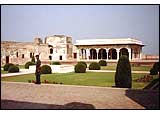 |
|
 |
Standing on
the ramparts of Lahore Fort, one can see out over the city in
many directions. Despite the density of modern urban settlement,
one can imagine the web of routes that led out in Mughal times
toward Multan in the south and Delhi in the east.

Today
the citizens of Lahore recall these Mughal connections when they
speak of the tunnels that ran from Lahore Fort to gardens in all
directions (Wescoat, Brand, and Mir, 1991). The most common tunnel
story links the fort, Shalamar, and Delhi — a path that reflects
the form and pattern of Lahore in the mid-seventeenth century,
at the pinnacle of its development.
 |
 |
|
|
 |
|
|
View
Past the Walls
of the Fort
|
|
|
|
|
|
There are
indeed extensive interconnected underground chambers beneath the
garden quadrangles of the fort, but none is known to extend beyond
the walls of the fort. There are also alleged tunnels in haveli
gardens of the walled city. Almost every blocked arch in a basement
chamber is said to have been linked with prominent gardens and
with the fort.

Tunnel stories
are common in many if not most parts of the world. Stafford (1984)
explores early modern scientific queries about underground caves
and tunnels. Subterranean tales have found expression in science
fiction, occult mysteries, lost worlds, and imaginary passages
encircling the world.

The more modest network of tunnel stories about Lahore and South
Asia reminds us of the historical connections between the city
and outlying places, and the enduring social need for connectivity
and coherence in the urban landscape.
|